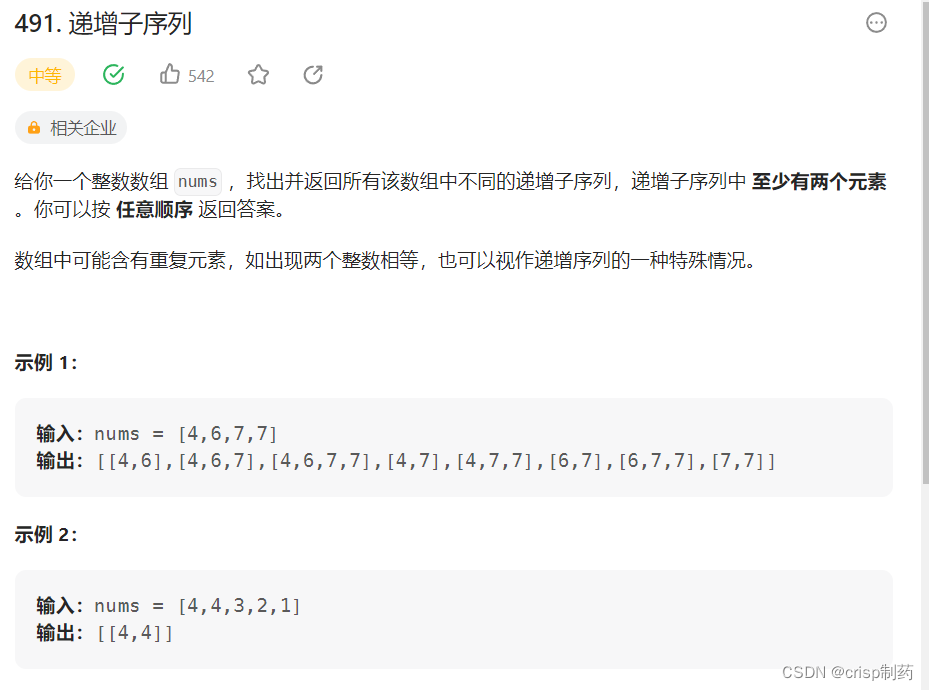-
算法刷题日志——回溯算法
全排列

used数组用来判断是否用过了
class Solution { List<List<Integer>> res = new ArrayList<>(); List<Integer> path = new ArrayList<>(); boolean[] used; public List<List<Integer>> permute(int[] nums) { int len = nums.length; if(len==0){ return res; } used = new boolean[len]; dfs(nums); return res; } public void dfs(int[]nums){ int n = nums.length; if(path.size()==n){ res.add(new ArrayList<>(path)); return; } for(int i=0;i<n;i++){ if(used[i]){ continue; }else{ path.add(nums[i]); used[i]=true; dfs(nums); path.remove(path.size()-1); used[i]=false; } } } }- 1
- 2
- 3
- 4
- 5
- 6
- 7
- 8
- 9
- 10
- 11
- 12
- 13
- 14
- 15
- 16
- 17
- 18
- 19
- 20
- 21
- 22
- 23
- 24
- 25
- 26
- 27
- 28
- 29
- 30
- 31
- 32
全排列 II

这里进行去重,有两种 一种用set进行去重,另外就是使用used数组进行判断去重
used数组去重:
class Solution { List<List<Integer>> res = new ArrayList<>(); List<Integer> path = new ArrayList<>(); boolean[] used; public List<List<Integer>> permuteUnique(int[] nums) { int len = nums.length; if(len==0){ return res; } used = new boolean[len]; Arrays.sort(nums); dfs(nums); return res; } public void dfs(int[]nums){ int n = nums.length; if(path.size()==n){ res.add(new ArrayList<>(path)); return; } for(int i=0;i<n;i++){ if(i>0 && nums[i]==nums[i-1] && used[i-1]==false){ continue; } if(used[i]==false){ path.add(nums[i]); used[i]=true; dfs(nums); path.remove(path.size()-1); used[i]=false; } } } }- 1
- 2
- 3
- 4
- 5
- 6
- 7
- 8
- 9
- 10
- 11
- 12
- 13
- 14
- 15
- 16
- 17
- 18
- 19
- 20
- 21
- 22
- 23
- 24
- 25
- 26
- 27
- 28
- 29
- 30
- 31
- 32
- 33
- 34
set去重:
class Solution { Set<List<Integer>> res = new HashSet<>(); List<Integer> path = new ArrayList<>(); boolean[] used; public List<List<Integer>> permuteUnique(int[] nums) { int len = nums.length; if(len==0){ return new ArrayList<>(res); } Arrays.sort(nums); used = new boolean[len]; dfs(nums); return new ArrayList<>(res); } public void dfs(int[] nums){ int n = nums.length; if(path.size()==n){ res.add(new ArrayList<>(path)); return; } for(int i=0;i<n;i++){ if(used[i]){ continue; } path.add(nums[i]); used[i]=true; dfs(nums); path.remove(path.size()-1); used[i]=false; } } }- 1
- 2
- 3
- 4
- 5
- 6
- 7
- 8
- 9
- 10
- 11
- 12
- 13
- 14
- 15
- 16
- 17
- 18
- 19
- 20
- 21
- 22
- 23
- 24
- 25
- 26
- 27
- 28
- 29
- 30
- 31
- 32
491. 递增子序列

本题求自增子序列,是不能对原数组经行排序的,这题可以不加终止条件,startIndex每次都会加1,并不会无限递归。同一父节点下的同层上使用过的元素就不能在使用了
Java中的Map提供了getOrDefault()方法,对不存在的键值提供默认值的方法。
// 存在Key1,返回11,不存在的话就返回22
System.out.println(map.getOrDefault(1,22));
这里用map来代替一个判断去重的数组,存在就返回1,不存在则返回0来进行判断,
而且map是记录本层元素是否重复使用,新的一层map都会重新定义(清空),所以要知道map只负责本层!class Solution { //结果集合 List<List<Integer>> res = new ArrayList<>(); //路径集合 LinkedList<Integer> path = new ArrayList<>(); public List<List<Integer>> findSubsequences(int[] nums) { getSubsequences(nums,0); return res; } private void getSubsequences( int[] nums, int start ) { if(path.size()>1 ){ res.add( new ArrayList<>(path) ); // 注意这里不要加return,要取树上的节点 } HashMap<Integer,Integer> map = new HashMap<>(); for(int i=start ;i < nums.length ;i++){ if(!path.isEmpty() && nums[i]< path.get(path.size()-1){ continue; } // 使用过了当前数字 if ( map.getOrDefault( nums[i],0 ) >=1 ){ continue; } map.put(nums[i],map.getOrDefault( nums[i],0 )+1); path.add( nums[i] ); getSubsequences( nums,i+1 ); path.remove(path.size()-1); } } }- 1
- 2
- 3
- 4
- 5
- 6
- 7
- 8
- 9
- 10
- 11
- 12
- 13
- 14
- 15
- 16
- 17
- 18
- 19
- 20
- 21
- 22
- 23
- 24
- 25
- 26
- 27
- 28
- 29
- 30
-
相关阅读:
计算机网络 基础知识 套接字 编程
【OpenGL概念】QOpenGLWidget类详述--此文档基于Qt5.14.2
Win10系统备份的方法和步骤
Java性能分析基础(一):常用工具
postgresql14-模式的管理(三)
CentOS用nginx搭建文件下载服务器
MATLAB绘图中文显示为方框
收集灵感都有哪些网站推荐?
1、基本概念
MacOS 控制固态磁盘写入量,设置定时任务监控
- 原文地址:https://blog.csdn.net/crisp0530/article/details/127804500
